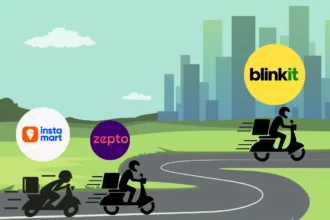Estimated Reading Time: 20-22 minutes ( 3,914 words)
Introduction
Indian cinema is no longer just a domestic cultural phenomenon — it’s becoming a global entertainment force, influencing Hollywood, dominating overseas box offices, and shaping storytelling trends across continents. Movies like RRR, Baahubali, Dangal, and Pathaan proved that Indian content can be globally commercial, not just diasporic. OTT platforms have pushed Indian storytelling into 190+ countries. Hollywood studios are increasingly co-producing with Indian companies. International festivals are featuring more Indian films than ever.
But how did this globalization happen? What’s driving it? What does the next decade look like? And how can filmmakers, creators, and even content publishers (like your blog) tap into this booming opportunity?
This in-depth guide breaks it all down — with stats, examples, case studies, and a strategic business outlook for 2025–2035.

Current Market Size of Indian Cinema
India’s Entertainment Economy Is Booming
According to the Motion Picture Association (MPA), Deloitte, and FICCI–EY (2024–2025), India’s screen entertainment sector is entering one of its fastest global expansion phases. Multiple revenue streams—box office, OTT, television, music rights, and overseas distribution—are experiencing simultaneous growth.
- India’s screen entertainment industry generated approx. USD 61.2 billion in 2024, driven by a sharp rise in OTT subscriptions, regional film dominance, and an increase in theatrical recovery post-pandemic.
- Film industry revenues alone are projected to reach USD 17.5 billion by FY2029 (base-case scenario), supported by higher content budgets, pan-India releases, and expansion into non-traditional global markets like Japan, Africa, Russia, and Latin America.
- In a high-growth scenario with supportive policies, improved infrastructure, and increased global distribution, India’s film sector could grow beyond USD 20 billion by FY2029, supported by government incentives, production subsidies, technological adoption (AI/VFX), and OTT–theatrical hybrid models.
India’s Global Cinema Positioning
India’s cinema market is not just growing domestically—it is now a major player in the global entertainment economy.
- India is the 3rd largest box office market globally, trailing only the U.S./Canada and China, with rising contribution from overseas territories such as the UAE, North America, the UK, and Australia.
- India is the world’s largest film producer, releasing 1,600+ films every year across more than 20 languages, including Hindi, Tamil, Telugu, Malayalam, Kannada, Marathi, Punjabi, Bengali, and more.
- Regional industries contribute more than 60–65% of total box office revenue, indicating a strong multi-industry ecosystem rather than a Bollywood-only market.
- India’s streaming audience (over 480+ million digital viewers) has become a massive global export engine, enabling films and series to reach worldwide audiences on release day.
Why These Figures Matter
These numbers highlight India’s immense global growth potential, especially as international distributors, film festivals, OTT platforms, and Hollywood studios show increasing interest in Indian storytelling. The combination of high content volume, rising global interest, and strong diaspora demand positions India as a future global entertainment hub—one capable of influencing international box office trends, content formats, and cultural narratives.
Global Trends Driving Indian Cinema’s Expansion
Trend 1: Explosive Overseas Box Office Growth
Between 2022–2024, Indian films recorded one of the fastest overseas growth phases in their history.
- International box office revenue for Indian films grew 30%+ year-on-year, crossing USD ~323 million by 2024.
- Much of this growth came from non-traditional markets, including Eastern Europe, Japan, and the Middle East.
- Major films such as Jawan, RRR, Pathaan, K.G.F: Chapter 2, Animal, Salaar, and Jailer crossed multi-million dollar collections abroad, proving that Indian cinema is now a viable global commercial product.
Trend 2: International Audiences Beyond the Diaspora
Indian films today appeal not only to NRIs but to global mainstream viewers.
- RRR became a cultural phenomenon in the U.S., Korea, and Japan, with packed theatres and repeat viewings.
- K.G.F built strong followings across Europe and Latin America, where fans actively engage on social media.
- Dangal and Baahubali opened the door to non-Indian markets, paving the way for regional industries to enter global charts.
This shift shows that Indian cinema is now consumed for its storytelling, action, music, and cultural uniqueness, not just nostalgia.
Trend 3: Streaming Platforms Accelerating Reach
OTT is the biggest global accelerator for Indian cinema. Platforms like Netflix, Amazon Prime Video, Disney+ Hotstar, SonyLIV, and Zee5 are pushing Indian content to 190+ countries, offering:
- 35+ subtitle languages (including Spanish, Japanese, Korean, Turkish, French, and Arabic)
- Multiple dubbed versions (Hindi, Tamil, Telugu, Malayalam, Kannada, English, and more)
- Front-page global placements for major Indian titles
- Massive marketing campaigns for pan-India films
This global exposure has created new fan communities and generated viral moments for Indian cinema.
Trend 4: Hollywood Collaborations Rising
Hollywood and India are collaborating more than ever.
Examples include:
- Fox Star Studios, Disney, Sony, and Warner Bros. co-producing or distributing Bollywood films.
- Indian VFX studios like Prime Focus, Red Chillies VFX, and Makuta working on Hollywood blockbusters (e.g., Avatar, Gravity, Avengers films).
- Hollywood-style international marketing for Indian films, with premieres in New York, Dubai, London, and Tokyo.
These partnerships elevate India’s reputation as a global production and post-production powerhouse.
Trend 5: Regional Cinemas Driving Global Breakthroughs
Since 2020, regional industries have surpassed Bollywood in global impact.
- Tollywood (Telugu) and Kollywood (Tamil) films frequently break international box office records.
- RRR, KGF, Kantara, Leo, Salaar, and Jailer achieved unprecedented overseas earnings.
These films introduced global audiences to high-concept action, folklore, music, and visually rich storytelling.
Regional cinema has become the engine behind India’s global cinematic identity.
Box Office Growth: India vs Overseas
Domestic Box Office (2024)
- India generated USD 1.5+ billion in box office revenue in 2024.
- This growth was led by all-India and pan-India blockbusters featuring:
- Shah Rukh Khan (Jawan, Pathaan)
- Prabhas (Salaar)
- Ranbir Kapoor (Animal)
- Allu Arjun (Pushpa 2 hype)
- Yash (KGF franchise)
- Shah Rukh Khan (Jawan, Pathaan)
- The surge in multiplex expansion, tier-2 city audiences, and pan-India releases contributed heavily to domestic growth.
Overseas Box Office (2024)
Indian films collected USD 323M+ overseas (Economic Times, 2024).
Key international markets include:
- U.S./Canada – the largest overseas market
- Middle East (UAE, Saudi Arabia, Qatar) – extremely strong for Bollywood
- U.K./Europe – consistent high-performing region
- Australia & New Zealand – record admissions for Indian titles
- Japan – Telegu and Tamil films gaining cult status
- Latin America (Brazil, Mexico, Argentina) – one of the fastest-growing fanbases
These markets now play a crucial role in determining a film’s global commercial success.
Why the Overseas Boom?
Several structural and audience-driven factors are fueling the surge:
- Improved global distribution through major studios and OTT-backed networks
- Higher international marketing budgets (trailers, premieres, influencer campaigns)
- Fan-driven global communities on Twitter/X, Reddit, TikTok, and YouTube
- Better production standards, especially in action, VFX, music, and sound mixing
- Pan-India content appeal, allowing films to travel across languages and cultures
Together, these factors have made Indian cinema a high-demand international entertainment product.
Hollywood–Bollywood Collaborations
Current Types of Collaborations
- Co-productions (Fox, Sony, Paramount with Indian studios)
- Distribution partnerships
- VFX outsourcing
- Talent crossovers (actors, technicians)
- Story rights adaptation
Examples of Successful Collaborations
- Slumdog Millionaire (Indian cast/crew, global production)
- The White Tiger (Netflix India–Hollywood combined effort)
- Indian VFX companies contributing to Avatar, Avengers, Life of Pi, etc.
The OTT Revolution: How Streaming Made India Global
OTT platforms have become the single most influential engine behind the globalization of Indian cinema. What traditional theatrical distribution could not achieve in 70 years, streaming platforms have accelerated in less than a decade. Today, Indian films, series, documentaries, and even stand-up specials are available to global audiences at the same time — often marketed as aggressively as Hollywood content.
Why OTT Changed Everything
- Global Simultaneous Releases
Indian films now drop on platforms like Netflix, Prime Video, Disney+ Hotstar, SonyLIV, and Zee5 in 190+ countries on the same day. This removes time-zone gaps, piracy issues, and regional delays, letting global audiences participate in release-day excitement. - Lower Distribution Barriers
Earlier, Indian films struggled for screen presence abroad due to limited theatres, diaspora-focused programming, and high distribution costs. OTT bypasses all of that — any film can reach global viewers without physical screens or regional distributors. - Content Discovery via Algorithms
Recommendation engines help non-Indian audiences discover Indian content through:
- Genre matching (action/adventure, romance, thriller)
- Similar watch histories
- Trending lists & global top 10 sections
Algorithms have broken cultural barriers by presenting Indian content to users who never actively searched for it.
- Genre matching (action/adventure, romance, thriller)
- Availability in Dozens of Languages
Major OTT releases now come with:
- 30–40+ subtitle languages
- 10–12 audio dubs (including English, Spanish, Arabic, Turkish, Korean, Japanese, French)
This accessibility has helped Indian cinema find fans across Latin America, Japan, South Korea, Eastern Europe, and Africa.
- 30–40+ subtitle languages
- Increased Acceptance of Indian Storytelling
OTT normalized Indian-style storytelling — musicals, family dramas, folklore-inspired action, and intense emotional arcs — for global viewers. Audiences now appreciate India’s cultural variety, regional diversity, and unique storytelling formats.
Impact of OTT on Indian Cinema’s Globalization
- India Is Now a Global Content-Exporting Nation
Instead of consuming Western content, India is exporting films, series, and documentaries that consistently appear in global top 10 lists, trend on social platforms, and receive international awards. - Smaller Films Get Global Visibility Without Theatrical Limitations
Indie films, regional cinema, and mid-budget titles — which previously struggled for screens — now reach millions globally. Movies like Minnal Murali, Kantara, 2018, Sita Ramam, and Siren became international hits largely due to OTT buzz. - Rise of Global Fandoms for Stars & Directors
Actors such as Allu Arjun, Yash, Nani, Rajinikanth, Dhanush, and Nawazuddin Siddiqui have built international fan communities through streaming exposure, expanding beyond diaspora-centric appeal. - OTT Has Created a Worldwide “Pan-India” Audience Viewers from multiple countries now consume Indian content regardless of its original language — Tamil, Telugu, Hindi, Malayalam, Kannada, Bengali, Punjabi, Gujarati, and more. This multicultural audience is redefining global film consumption patterns.
Regional Indian Cinema’s Rise
Regional industries are no longer “regional”—they are now pan-India and global powerhouses shaping India’s cinematic identity worldwide.
Tollywood (Telugu)
- Pioneered India’s global blockbuster wave with Baahubali, Saaho, Pushpa, and RRR.
- RRR’s Oscar & Golden Globe wins boosted worldwide credibility for Telugu filmmaking.
- Mastered the “pan-India release model” with multi-language launches across 70+ countries.
- Big-scale filmmaking, VFX, and mass storytelling set new international benchmarks.
Kollywood (Tamil)
- Delivered consistent global hits: Jailer, Leo, Vikram, Ponniyin Selvan, etc.
- Strong presence in Gulf countries, Singapore, Malaysia, and Sri Lanka due to large Tamil diaspora.
- Known for genre diversity—from gritty thrillers to historical epics.
- Strong director-driven ecosystem led by Lokesh Kanagaraj, Nelson, and Shankar.

Mollywood (Malayalam)
- Gaining cult global status with films like 2018, Manjummel Boys, Jallikattu, Drishyam.
- Recognized for grounded, realistic, character-driven stories that appeal internationally.
- High-quality scripts and low-budget efficiency attract OTT global audiences.
- Strong representation in international film festival circuits.
Sandalwood (Kannada)
- KGF 1 & 2 redefined Kannada cinema and achieved worldwide box-office dominance.
- Created a new “raw, stylish action” template admired across Asia.
- Inspired more large-scale Kannada productions targeting global fans.
- Yash became a global star, boosting interest in Kannada cinema.
Why Regional Cinema Is Winning Globally
- Unique storytelling styles rooted in local culture but universal in emotion.
- High-end production value—cinematography, VFX, world-building.
- Strong hero-driven franchises that attract mass audiences worldwide.
- Dubbing & subtitling boom: multi-language releases allow films to cross linguistic boundaries.
- OTT platforms amplify reach, enabling regional hits to trend in 100+ countries.
- Diaspora audiences + non-Indian viewers now actively explore regional titles.
Case Studies: Indian Films That Went Global
RRR (2022)
- Won Oscar for Best Original Song.
- Broke into U.S. mainstream culture.
- Massive Japanese and Korean fanbase.
Dangal (2016)
- Earned USD 250+ million in China alone.
Baahubali Franchise
- Opened doors for pan-India cinema.
- Dubbed into 40+ languages worldwide.
Pathaan (2023)
SRK’s global comeback with strong overseas collections.
Indian Talent in Hollywood
Actors
- Priyanka Chopra
- Irrfan Khan
- Deepika Padukone
- Ali Fazal
- Dhanush
Directors / Technicians
- Mira Nair
- Shekhar Kapur
- Resul Pookutty (Oscar winner)
- Indian VFX directors across Marvel films
Soft Power: India’s Cultural Influence via Cinema
Indian cinema enhances global perceptions of India:
- Showcases Indian culture, values, music, fashion
- Drives tourism (YRF movies boosted Switzerland tourism)
- Increases demand for yoga, cuisine, textiles
- Strengthens India’s diplomatic image
- Cinema is now a pillar of India’s soft power strategy.
Challenges in Globalizing Indian Cinema
1. Cultural Translation Issues
- Many Indian films rely heavily on local cultural references, family norms, or humor that doesn’t translate well globally.
- Song-and-dance formats, melodrama, or mythological themes may feel unfamiliar to non-Indian audiences.
- Subtitles sometimes fail to capture linguistic nuance, reducing emotional impact.
2. Limited Screens Overseas
- Indian movies often receive fewer theatrical screens than Hollywood or local titles in key markets like the US, UK, and Europe.
- Release windows are shorter, making it harder to build word-of-mouth.
- Competition from global blockbusters limits screen availability even during festivals.
3. Marketing Budget Constraints
- Most Indian productions spend significantly less on global marketing compared to Hollywood’s massive promotional budgets.
- Limited investment in international PR, influencers, festival circuits, and localized campaigns reduces visibility.
- Studios often rely on diaspora-led word-of-mouth instead of structured marketing.
4. Regulatory & Policy Risks
- Foreign film industries face risks such as content regulation, censorship, piracy laws, and import restrictions in multiple countries.
- Example: Proposed U.S. tariffs on certain foreign media could increase distribution costs for Indian titles.
- Visa, tax, and co-production policy uncertainties hinder smooth global expansion.
5. Domestic Competition
- India’s own film ecosystem is rapidly diversifying—Telugu, Tamil, Kannada, and Malayalam films now compete for pan-India screens, budgets, and audience attention.
- Big regional industries often overshadow smaller Hindi or indie films, slowing their global traction.
- Fragmentation across language industries makes it harder to build a unified global cinematic identity.
10-Year Outlook (2025–2035)
1. Indian film revenues may cross USD 25–30B by 2035.
2. Overseas revenues likely to triple.
3. Regional cinema will dominate global expansion.
4. Indian filmmakers will collaborate more with Hollywood.
5. India will become a global VFX + post-production hub.
6. OTT will be the largest global distribution channel.
7. India’s soft power will reach K-pop levels of influence.
FAQs Section
1. How is Indian cinema becoming global?
Indian cinema is going global through a combination of OTT distribution, overseas theatrical expansion, Hollywood collaborations, and growing international fan communities. Platforms like Netflix and Amazon Prime now release Indian films in 190+ countries, often with 30–40 subtitle languages. Regional blockbusters (RRR, KGF, Jawan) are breaking cultural barriers through dubbed versions and aggressive global marketing. Meanwhile, Hollywood is increasingly engaging Indian studios for co-productions, VFX, and talent, helping Indian cinema integrate into the global entertainment supply chain.
2. Why are Indian movies becoming popular worldwide?
Indian movies are gaining worldwide popularity because they offer a unique blend of high emotional drama, strong characters, powerful music, and visually rich storytelling. Unlike Western films that lean more on realism, Indian cinema delivers spectacle, scale, and emotional connect, which appeals to audiences in Asia, Africa, Europe, and Latin America. Social media virality, especially around dance sequences, action set pieces, and iconic dialogues, has helped Indian films break into algorithm-driven discovery trends on TikTok, YouTube Shorts, and Instagram Reels.
3. What role does streaming (OTT) play in promoting Indian cinema globally?
OTT platforms have been the single biggest globalizer of Indian cinema:
How OTT boosts global reach
- Simultaneous worldwide release removes barriers of geography and distribution.
- Personalized recommendation algorithms introduce Indian content to non-Indian audiences.
- Dubbing & subtitles make movies accessible in dozens of languages.
- Long-tail viewership helps older films gain new life beyond theatres.
Key impact
Shows like Sacred Games, The Family Man, and films like RRR gained massive worldwide fanbases because OTT platforms gave them front-page placement in global catalogues, something theatres rarely do.
4. Which Indian movies have performed exceptionally well overseas?
Several Indian movies have delivered extraordinary overseas success:
- Dangal (2016) – USD 250M+ in China alone; one of the highest-grossing non-English films in history.
- RRR (2022) – Won an Oscar and Golden Globe; became a U.S. cultural phenomenon.
- Baahubali 1 & 2 – Established India’s global “epic cinema” identity; wide reach in Europe and Japan.
- K.G.F Franchise – Built a global fandom around Kannada cinema.
- Pathaan (2023) – SRK’s global comeback, major collections in the Middle East, U.S., U.K., Australia.
These films worked globally because of universal themes, action-heavy narratives, strong characters, and high production values.
5. How are regional industries (Tollywood, Kollywood, Sandalwood) contributing to globalization?
Regional industries now drive over 60% of global Indian cinema influence:
Tollywood (Telugu)
- Massive success with RRR, Pushpa, Baahubali
- Strong overseas presence in U.S., Japan, and Middle East
- Known for high-budget spectacle filmmaking
Kollywood (Tamil)
- Films like Leo, Jailer, Vikram appeal internationally
- Strong action choreography and storytelling depth
Sandalwood (Kannada)
- K.G.F placed the industry on the global map
- Known for gritty visual style
Mollywood (Malayalam)
- Widely appreciated for realistic narratives and character-driven cinema
- Cult global following through OTT
These industries are increasingly preferred globally due to fresh themes, variety, and visual innovation.
6. What challenges does Indian cinema face in going global?
Despite growth, several challenges persist:
- Limited screen availability overseas compared to Hollywood films
- Cultural translation barriers — some narratives don’t resonate universally
- Lack of global marketing budgets
- Competition from Korean, Japanese, and Hollywood content
- Censorship or trade regulations in foreign countries
- Overdependence on diaspora audiences in certain markets
To sustain globalization, Indian studios must invest more in international PR, distribution networks, and cross-cultural storytelling.
7. How is Bollywood collaborating with Hollywood?
Bollywood–Hollywood collaboration is expanding in multiple areas:
1. Co-productions
Studios like Fox Star, Sony Pictures, and Disney collaborate with Indian production houses.
2. Talent exchange
Indian actors appearing in Hollywood films:
Priyanka Chopra, Dhanush, Irrfan Khan, Deepika Padukone, Ali Fazal.
3. VFX & post-production
Indian VFX companies work on major Hollywood films like Avatar, Avengers, Life of Pi, The Jungle Book.
4. Remakes & adaptation rights
Hollywood remakes of Indian concepts and vice versa.
These collaborations expand India’s technical footprint and soft power influence.
8. Why are non-Indian audiences suddenly interested in Indian films?
Non-Indian audiences are drawn due to:
- Escapism blended with emotions and spectacle
- Fresh storytelling formats compared to Western cinema
- Culturally rich visuals, music, and dance
- Social media virality (e.g., “Naatu Naatu”)
- Increased accessibility via dubbing/subtitles
- Rising global curiosity toward South Asian culture
- Authentic characters and mythological inspiration
Indian cinema stands out as entertainment-first, emotion-heavy, and culturally vibrant, offering a refreshing change for global viewers.
9. What markets outside India are most important for Indian films?
Major overseas markets include:
- United States & Canada – largest revenue generator
- UAE & Middle East – heavy expat presence
- U.K. & Europe – strong diaspora + growing non-Indian viewership
- Australia & New Zealand – high per-screen averages
- Japan – massive love for RRR, Baahubali, Indian animation
- China – unpredictable but powerful (Dangal, Secret Superstar)
- Latin America – fastest-growing fandom (Brazil, Mexico, Argentina)
These regions now shape international box office strategies for Indian studios.
10. What is the future of Indian cinema in the global market (2025–2035)?
The next decade is poised for explosive growth:
- Indian film revenues may cross USD 25–30B by 2035
- International box office may triple
- India could become the world’s largest film production hub
- More Indian films will enter Oscars, Cannes, TIFF, Sundance
- Regional cinema will drive 70%+ overseas growth
- India may rival Korea’s K-pop/K-drama soft power wave
- Hollywood will increasingly depend on Indian VFX and animation talent
- OTT platforms will release Indian originals exclusively for global audiences
The 2025–2035 era will position Indian cinema as a global entertainment and cultural leader.
11. Which Indian actors have the strongest global presence?
Top internationally recognized Indian actors include:
- Priyanka Chopra Jonas – Hollywood films & series
- Irrfan Khan – Life of Pi, Jurassic World
- Deepika Padukone – xXx franchise
- Dhanush – The Gray Man
- Ali Fazal – Death on the Nile, Victoria & Abdul
- Shah Rukh Khan – Global stardom across 80+ countries
- Ram Charan & Jr NTR – RRR fame
- Prabhas – Baahubali, Salaar
These actors have crossed linguistic and cultural boundaries with universal appeal.
12. Will Indian cinema ever compete directly with Hollywood?
Indian cinema may not replace Hollywood, but it will compete alongside it in:
- Global box office share
- Streaming content popularity
- VFX & technical talent supply
- Cultural influence (music, fashion, tourism)
- Fan-driven global franchises
With films like RRR already making mainstream American impact, India is fast becoming a parallel cinematic superpower, similar to Korea, Japan, and China.
13. How much do Indian films earn overseas on average?
A mid-range Indian film earns:
- USD 3–7 million overseas (Bollywood)
- USD 7–12 million (Telugu or Tamil blockbusters)
- Some titles cross USD 20–30 million
- Rare mega-hits like Dangal cross USD 250+ million
Overseas revenue forms 25–40% of total earnings for top-tier films today.
14. How can filmmakers make Indian movies more globally appealing?
Filmmakers can improve global appeal by:
- Focusing on universal themes (family, revenge, courage, love)
- Investing in global-quality VFX and cinematography
- Using concise screenwriting to match international expectations
- Releasing dubs/subtitles in 20–40 languages
- Collaborating with international actors and technicians
- Leveraging social media virality early
- Building franchises and cinematic universes
15. Which Indian OTT shows became globally popular?
Some globally acclaimed Indian web series include:
- Sacred Games (Netflix)
- The Family Man (Prime Video)
- Delhi Crime (International Emmy winner)
- Mirzapur (Prime Video)
- Made in Heaven
- Kota Factory
- RRR (Netflix release boost)
These shows attracted viewers in North America, Europe, Japan, and Latin America through strong characters, gritty realism, and bold narratives.
Summary / Key Takeaways
- Indian cinema is becoming a global entertainment force.
More Indian films are entering global charts, winning awards, and receiving mainstream recognition across the US, Europe, Japan, and the Middle East. - Overseas revenues are rising faster than domestic.
For major Bollywood and regional films, international markets now contribute a significant share of total box office earnings, especially the US, UAE, UK, Australia, and Southeast Asia. - OTT platforms have expanded worldwide reach.
Netflix, Prime Video, Disney+ Hotstar, and others have taken Indian content to 190+ countries through subtitles, dubbing, and global marketing pushes. - Regional cinema is driving most global breakthroughs.
Telugu, Tamil, Kannada, and Malayalam industries—through films like RRR, KGF, Kantara, and Leo—are achieving stronger global traction than many Bollywood titles. - Hollywood collaborations and Indian talent are increasing.
Indian actors, directors, writers, and VFX studios are partnering with major global studios, improving India’s footprint in international entertainment. - India’s cultural soft power is growing.
Indian films, music, and storytelling are influencing global pop culture, fashion, and online communities, strengthening India’s cultural presence worldwide.

Conclusion
The globalization of Indian cinema is no longer a passing phase — it marks a transformational moment in world entertainment. Indian industries across Bollywood, Tollywood, Kollywood, Sandalwood, and Mollywood have evolved into world-class storytellers producing visually rich, culturally rooted, and commercially powerful narratives. With rising production quality, global distribution networks, and strong diaspora support, Indian films now regularly enter international box office charts, receive global awards, and inspire cross-cultural dialogue. This shift signals that Indian cinema is not simply expanding outward but actively shaping global tastes.
Over the next decade, India is poised to become one of the world’s most influential content exporters. The combination of OTT growth, Hollywood collaborations, AI-driven production tools, and global fan communities means Indian cinema will increasingly dictate trends in storytelling, music, world-building, and franchise creation. Regional industries, in particular, are set to play a pivotal role, as they continue outperforming in global markets with high-concept, universally appealing narratives. As more talent, technology, and capital flow into film production, India is entering a “global-first filmmaking era” where movies are crafted with worldwide audiences in mind.
For creators, investors, marketers, media publishers, and entertainment entrepreneurs, this is the ideal moment to build within the Indian cinema ecosystem. Whether through content creation, OTT partnerships, IP monetization, digital communities, or cross-border collaborations, the opportunities are expanding rapidly. Indian cinema is no longer waiting for global recognition — it is leading the charge, redefining cultural soft power, and positioning India as a major creative force for decades to come.
References & Sources
- Statista – Global box office & OTT market reports
Data on international earnings of Indian films, streaming growth, and country-wise audience trends. - FICCI–EY Media & Entertainment Report
Annual insights on India’s film, OTT, and regional cinema growth, including revenue forecasts and export potential. - Deloitte India – Entertainment & Media Outlook
Analysis of digital consumption, overseas markets, and the rising impact of regional films. - KPMG India – Media & Entertainment (M&E) Report
Covers industry size, global distribution patterns, and the evolution of Indian film monetization models. - Ormax Media – OTT & Film Audience Insights
Provides data on streaming viewership, pan-India audience behavior, and international consumption of Indian content. - Box Office Mojo & Comscore
Verified international box office performance for Bollywood and regional Indian films. - Netflix & Amazon Prime Video Press Releases
Announcements on global distribution, most-watched Indian titles, and content investment plans. - The Economic Times & Business Standard
Articles covering Indian cinema’s global expansion, Hollywood collaborations, and international box office trends. - Variety & The Hollywood Reporter
Reports on Indian films breaking into Hollywood circuits, festival wins, and global industry reactions. - UNESCO & MEA India (Soft Power Reports)
Context on India’s cultural influence, global content exports, and international cultural diplomacy.







